In the mid-1990s after the fall of the Berlin Wall, Dr. Ashok K. Chauhan shook the dust of reunited Germany from his feet and famously reverse migrated to India. Since then the Amity Group has developed into post-liberalisation India’s fastest growing end-to-end education conglomerate with global ambitions. Dilip Thakore reports
.gif) Founder’s Day (October 24) is a very important date in the annual calendar of the Delhi/Noida-based Amity Group of education institutions. Since 1991 when the Ritnand Balved Education Foundation promoted the Amity International School, Saket, Delhi, and particularly after Amity University, Uttar Pradesh (UP) was established by an enactment of the UP state legislative assembly in 2005, the foundation has set a blazing pace of academic growth and development to metamorphose the Amity Group into arguably the largest private education provider of pre-primary-Ph D education in the Indian subcontinent.
Founder’s Day (October 24) is a very important date in the annual calendar of the Delhi/Noida-based Amity Group of education institutions. Since 1991 when the Ritnand Balved Education Foundation promoted the Amity International School, Saket, Delhi, and particularly after Amity University, Uttar Pradesh (UP) was established by an enactment of the UP state legislative assembly in 2005, the foundation has set a blazing pace of academic growth and development to metamorphose the Amity Group into arguably the largest private education provider of pre-primary-Ph D education in the Indian subcontinent.
Now, even as this feature is being written, the administrative office of the Amity Group sited on the sprawling 60-acre state-of-the-art American-style campus of Amity University, Noida, characterised by its 22 red-brick modernist buildings housing 516 hi-tech classrooms, three seminar halls, four auditoriums, 300 busy laboratories and 15 acres of playing fields, is abuzz with activity as it prepares to host 32 contingents from Amity institutions in Jaipur, Lucknow, Bhubaneshwar, Chandigarh, Bangalore, Kolkata, Mumbai, Indore, Ahmedabad etc. Students from these academic outposts of the group will converge in Noida for a week and face off in several field games, tournaments and athletic and aquatic meets, and also stage musical and cultural events on Founder’s Day.
Not entirely coincidentally, October 24 is the birthday of the fast-track Amity Group’s founder-president Dr. Ashok K. Chauhan, hitherto the most successful Indian businessman-entrepr-eneur in Germany and continental Europe. In the early 1990s, after the fall of the Berlin Wall, Chauhan shook the dust of re-united Germany from his feet and famously reverse migrated to India to focus on developing and establishing Amity into post-liberalisation India’s fastest growing end-to-end education conglomerate.
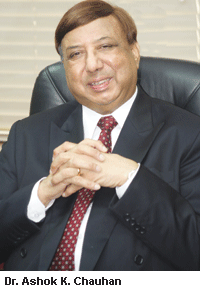 “After over 30 years’ stay in western Germany and doing business all over the world, I realised that Indian brains are the best in the world. But there was a big disparity in the quality of education available in the Western world and to potentially brilliant minds in India. It is then that I set my mind to start academic institutions in India and in 1986, the non-profit Ritnand Balved Education Foundation was registered for this purpose, with the mission to modernize India and transform the country into a hub of education offering a synthesis of the best in Western science and learning combined with Indian spiritual values and traditions,” says Chauhan.
“After over 30 years’ stay in western Germany and doing business all over the world, I realised that Indian brains are the best in the world. But there was a big disparity in the quality of education available in the Western world and to potentially brilliant minds in India. It is then that I set my mind to start academic institutions in India and in 1986, the non-profit Ritnand Balved Education Foundation was registered for this purpose, with the mission to modernize India and transform the country into a hub of education offering a synthesis of the best in Western science and learning combined with Indian spiritual values and traditions,” says Chauhan.
Germany’s loss turned out to be India’s gain. In the past two decades Chauhan has invested his business and institutional development expertise in post-liberalisation India’s resurgent education sector and transformed the Amity Group into a powerhouse of Indian education. A chemistry alumnus of Agra University who began his career in the petrochemicals division of DCM Ltd in Kota, Rajasthan (1963-67), Chauhan won a scholarship to Wurzburg University, West Germany in 1967. Painstakingly learning German, he began his career as a research scientist in the Switzerland-based Datwyler Group, rising to the position of head of research within two years. But in 1972, after his marriage to Amita, a Sanskrit scholar of Kurukshetra University, Chauhan went solo and started the AKC Group of companies in Celle, near Hannover and later headquartered in Frankfurt, West Germany. Over the next decade he grew the AKC Group into a multi-billion dollar conglomerate. But in the mid 1990s after he took a fateful decision to invest heavily in former communist East Germany, the AKC Group was embroiled in several law suits and legal proceedings — “all of which have since been resolved” — prompting his reverse migration to India to focus on developing the fledgling Amity Group institutions.
There’s no doubt that the middle class student community in resurgent post-liberalisation India — which has doubled its annual GDP rate of growth from the traditional 3.5 percent per year in the period 1956-85 to an average 7 percent plus since its infamous licence-permit-quota regime was substantially dismantled in the historic budget of July 1991 — has benefitted enormously following Chauhan’s return from Germany in 1994. Currently the number of smart patently middle and upper middle class students enroled in the Amity Group’s two universities (in Uttar Pradesh and Rajasthan), housing 150 institutes and faculties, eight K-12 schools and four preschools spread over disparate campuses aggregating 1,000 acres of real estate housing 5.1 million sq. ft of hi-tech buildings, is 65,000 in 240 study programmes.
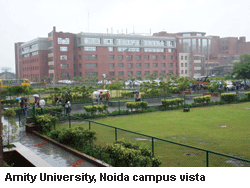 Moreover taking into consideration that the special Amity University Act was passed by the Uttar Pradesh state government as recently as 2005, the management’s development of its state-of-the-art Noida campus in record time is a feat perhaps unmatched by any education institution in the subcont-inent and on a par with the project execution skills of the Ambani brothers of Indian industry. And it’s pertinent to note that the American-style Noida campus spread over 60 acres, is only one of the 150 institutions of the Amity Group. Another 40 acre campus of Amity University, Uttar Pradesh with a student population of 6,000 enroled in 32 study programmes is operational in Lucknow; and a perhaps even more ambitious Amity University of Rajasthan spread over a 150 acre campus on the outskirts of Jaipur came on stream in 2007 and already has an enrolment of 1,800 students. Nor is that all. Bullish about the prospects of private education providers under the newly elected Congress-led UPA government and particularly Union HRD minister Kapil Sibal, the Amity Group intends to establish an additional 33 Amity Universities — one in every state of the Indian Union.
Moreover taking into consideration that the special Amity University Act was passed by the Uttar Pradesh state government as recently as 2005, the management’s development of its state-of-the-art Noida campus in record time is a feat perhaps unmatched by any education institution in the subcont-inent and on a par with the project execution skills of the Ambani brothers of Indian industry. And it’s pertinent to note that the American-style Noida campus spread over 60 acres, is only one of the 150 institutions of the Amity Group. Another 40 acre campus of Amity University, Uttar Pradesh with a student population of 6,000 enroled in 32 study programmes is operational in Lucknow; and a perhaps even more ambitious Amity University of Rajasthan spread over a 150 acre campus on the outskirts of Jaipur came on stream in 2007 and already has an enrolment of 1,800 students. Nor is that all. Bullish about the prospects of private education providers under the newly elected Congress-led UPA government and particularly Union HRD minister Kapil Sibal, the Amity Group intends to establish an additional 33 Amity Universities — one in every state of the Indian Union.
Although the paterfamilias Dr. Chauhan is widely acknowledged as the visionary and enabler of the Amity Group which has leapfrogged other private higher education providers (Manipal Education, Shiv Subramaniya Nadar (SSN) Group, VIT Vellore etc) and claims that Amity University, Uttar Pradesh is the country’s premier private sector university, there’s general consensus that Amity’s growth and development has also been driven by the management and project execution skills of Dr. Chauhan’s two (of five) highly educated sons Atul and Aseem, who took on India’s notoriously obstructive bureaucracy to engineer the massive projects of Amity.
In 1991 the group’s first initiative, Amity International School in Saket (Delhi) admitted its first batch of 349 students. It was followed by the Amity International School and Amity Business School, established in the then barren stretches of Noida, a suburb of Delhi which spills into Uttar Pradesh, India’s most populous (166 million) and arguably most socio-economically backward state.
In this wilderness and with great courage and foresight, the Amity Business School was constructed as per the blueprint of Delhi-based architect Vijay Gupta. Since then it has transformed into a thoroughly contemporary campus with distinctive Italian-style red brick buildings, wide boulevards, spacious corridors and classrooms with sufficient provision for continuous promotion and growth of other schools and faculties. In 2005 the schools and faculties established on the Noida campus — then affiliated with the Delhi and several other government universities — flowered into Amity University, established by the Amity University Act, 2005 passed by the Uttar Pradesh state legislative assembly.
Credit for this growth and development strategy which outflanked the then incumbent dyed-in-the-wool socialist Union minister of human resource development Arjun Singh who was resolutely opposed to private sector initiatives in higher education, is unanimously given to Atul Chauhan, the suave University College and London School of Economics educated eldest scion of the Chauhan clan. According to knowledgeable sources within the group, confronted with the obduracy of the HRD ministry, Atul hit upon the strategy of persuading the Samajwadi party government in Lucknow to steer the Amity University Act, 2005 through the state’s legislative assembly.
Inevitably this outflanking mano-euvre, which resulted in the UP state legislative assembly enacting legislation under s.2(f) of the University Grants Commission Act, 1956 transforming the Amity campus in Noida (UP) into a fully-fledged autonomous university, didn’t go down well with the Union HRD ministry and the education establish-ment in New Delhi. Reacting with typical bureaucratic malice, UGC stubbornly refused to include the newly constituted university in a list of approved universities which the commission maintains on its website. This created widespread misapprehen-sion in India and abroad that the newly enfranchised Amity University was not ‘recognised’ by UGC. And the Amity management was compelled to file a writ petition in the Delhi high court praying for an order directing UGC to include the new university in its list of recognised institutions.
Rejecting UGC counsel’s argument that its website list was non-statutory, i.e not required by law and was illustrative rather than exhaustive, in Amity University vs.Union of India & Ors (WP 18188 of 2006), Justice Badar Durerez Ahmed held that UGC is a public body dischar-ging public functions, and while it had the discretion not to maintain the impugned list of universities, once it decides to do so, “it is not open to UGC to pick and choose and arbitrarily deny inclusion of the petitioner’s name in the said list”. Since Amity had been duly proclaimed a university by a state government as provided in s.2(f) of the UGC Act, the court directed the commission to include Amity in its website list. This famous victory in the high court (which UGC has appealed and lost) prompted the Amity Group management to launch an advertising blitzkrieg in the media, particularly television, proclaiming that Amity University is recognised by UGC.
 “A reading of the UGC Act shows that the commission’s role is restricted to awarding grants and maintenance of norms and standards across the country,” says Atul Chauhan, chancellor of Amity University, Uttar Pradesh which comprises the Noida and Lucknow campuses with an aggregate enrolment of 25,000 students. “Therefore since the commission was voluntarily maintaining a non-statutory list of approved universities but unreasonably refused to include Amity University in it, we were reluctantly obliged to move the court. As Amity is a full-fledged university in its own right, we have the freedom to define our own syllabuses and curriculums and award degrees. We have been utilising these freedoms very responsibly to design industry-oriented courses to ensure that our students are industry-ready when they graduate. The parent and students’ communities are appreciative of our autonomy and commitment to provide globally-benchmarked world class education in Amity University. Against the annual intake of 6,000 students we receive over 120,000 admission applications for our 240 study programmes. At Amity we benchmark against the best universities in the world and have this year established Amity campuses in London and Singapore. Our campuses in New York and Dubai will come up shortly. We want to show that Indian institutions can truly compete at the global level.”
“A reading of the UGC Act shows that the commission’s role is restricted to awarding grants and maintenance of norms and standards across the country,” says Atul Chauhan, chancellor of Amity University, Uttar Pradesh which comprises the Noida and Lucknow campuses with an aggregate enrolment of 25,000 students. “Therefore since the commission was voluntarily maintaining a non-statutory list of approved universities but unreasonably refused to include Amity University in it, we were reluctantly obliged to move the court. As Amity is a full-fledged university in its own right, we have the freedom to define our own syllabuses and curriculums and award degrees. We have been utilising these freedoms very responsibly to design industry-oriented courses to ensure that our students are industry-ready when they graduate. The parent and students’ communities are appreciative of our autonomy and commitment to provide globally-benchmarked world class education in Amity University. Against the annual intake of 6,000 students we receive over 120,000 admission applications for our 240 study programmes. At Amity we benchmark against the best universities in the world and have this year established Amity campuses in London and Singapore. Our campuses in New York and Dubai will come up shortly. We want to show that Indian institutions can truly compete at the global level.”
The proven strategy of persuading state governments to grant university status to education institutions through special enabling legislation, has been adopted by Amity’s top management to establish the group’s footprint country-wide. State governments tend to be more receptive of private higher education institutions rather than the Central government which tends to be overbearing. Leveraging this discovery, Aseem Chauhan — a systems engineering and finance management alumnus of the Wharton Business School and former venture capitalist in the US (1996-2001) who returned to India in 2002 to work with the RBE Foundation — is master-minding an unprecedented initiative to plant the Amity Group flag across the country.
In hot pursuit of this objective, Amity University, Rajasthan is being constr-ucted on 150 acres, which features an on-campus golf range, horse-riding club, and state-of-the-art sports com-plex, and has already become operational with an enrolment of 1,800 students in 14 study programmes. Moreover 15 spearhead Amity Business Schools across the country, which following the Noida pattern will gradually flower into fully-fledged universities, have been established countrywide and in New York, London and Singapore.
 “We believe we have successfully conceptualised and delivered a higher education model which offers a sound value-proposition to the 65,000 students pursuing market-priced study programmes in our existing institutions and campuses across the country. The same value-proposition is the rationale of our plan to establish Amity Universities abroad. For instance, currently the great majority of 100,000 Indian students entering US universities every year, sign up with second and third tier institutions. We are confident that we can offer them first tier education employing top American faculty combined with Indian values and cultural inputs in the US itself. Applying this logic we intend to establish Amity schools and universities not only in the US, but in Africa, the Middle East and even South America,” says Aseem Chauhan.
“We believe we have successfully conceptualised and delivered a higher education model which offers a sound value-proposition to the 65,000 students pursuing market-priced study programmes in our existing institutions and campuses across the country. The same value-proposition is the rationale of our plan to establish Amity Universities abroad. For instance, currently the great majority of 100,000 Indian students entering US universities every year, sign up with second and third tier institutions. We are confident that we can offer them first tier education employing top American faculty combined with Indian values and cultural inputs in the US itself. Applying this logic we intend to establish Amity schools and universities not only in the US, but in Africa, the Middle East and even South America,” says Aseem Chauhan.
The Amity growth blueprint under which Dr. Chauhan sets the group’s objectives and manages the larger environment (necessary because the licence-permit-quota regime which cabined, cribbed and confined Indian industry for over three decades prior to the liberalisation and deregulation initiative of 1991 has migrated with a vengeance to the education sector), and his highly qualified finance-savvy sons swiftly execute projects on the ground Ambani-Reliance style, has almost overnight transformed the group into India’s largest and most high-potential pre-school to Ph D education conglomerate.
Yet this growth model has worked because while at the apex level the management of the Amity Group is tightly controlled by the Chauhan triumvirate, at the operational level within the group’s institutes and faculties, administrators and academics enjoy wide freedom to frame syllabuses, curriculums and initiate academic innovations. For instance in the Amity Business School, Noida — the largest postgrad institution of Amity University which has an enrolment of 2,400 students instructed by 165 faculty in its 24-month business management programme — the curriculum requires all students to study functional general management in the first year, while in second year they have the choice to specialise in any one of 120 subjects, “the widest choice offered by any B-school in India”.
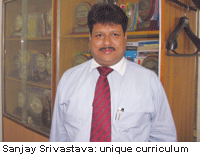 “In addition to our rigorous industry-oriented curriculum, we have devised a unique four-tier — industry, alumni, faculty and parent — mentoring programme which ensures every student gets maximum industry exposure and psychological support. Moreover our students are supported by an excellent fully-wired library stocked with 60,000 volumes, 17,000 e-journal subscriptions and life skills training programmes. Quite obviously our unique curriculum appeals to parent/students and Indian industry because for every seat, we receive over 30 applications. And despite the economic downturn globally, we had a 100 percent placement record at start-up salaries ranging from Rs.4-14 lakh,” says Dr. Sanjay Srivastava, a psychology and organisational behaviour alumnus of Delhi University and former faculty member of the government of India’s Department of Personnel and Training, Delhi (1993-98) who is the additional director general of Amity Business School, Noida.
“In addition to our rigorous industry-oriented curriculum, we have devised a unique four-tier — industry, alumni, faculty and parent — mentoring programme which ensures every student gets maximum industry exposure and psychological support. Moreover our students are supported by an excellent fully-wired library stocked with 60,000 volumes, 17,000 e-journal subscriptions and life skills training programmes. Quite obviously our unique curriculum appeals to parent/students and Indian industry because for every seat, we receive over 30 applications. And despite the economic downturn globally, we had a 100 percent placement record at start-up salaries ranging from Rs.4-14 lakh,” says Dr. Sanjay Srivastava, a psychology and organisational behaviour alumnus of Delhi University and former faculty member of the government of India’s Department of Personnel and Training, Delhi (1993-98) who is the additional director general of Amity Business School, Noida.
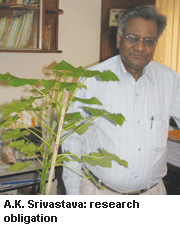 Likewise Dr. A.K. Srivastava (no relation) who heads the Amity Institute of Biotechnology — which has an aggregate of 2,400 students — enjoys wide academic freedom to design curriculums and commission research projects. “This institute is nationally renowned for its deep engagement in eco-friendly technologies research in collaboration with Indian industry. We have patented some 15 plants and processes — including the miracle jathropa, drumstick, amla and dathura plants — and are on the threshold of finding cures for peptic ulcer, kalahazar and breast cancer by converting their biochemical properties into benign synthetic drugs and formulations, in collaboration with leading pharma companies such as Ranbaxy and Dabur. The unique characteristic of this institute is that all our 127 faculty are obliged to be engaged in teaching and research simultaneously,” says Dr. Srivastava who has researched India’s rich biodiversity for almost half a century at Benares Hindu University, Punjab Agriculture University and IARI, Delhi, prior to taking charge as director at the Amity Institute of Biotechnology in 2002.
Likewise Dr. A.K. Srivastava (no relation) who heads the Amity Institute of Biotechnology — which has an aggregate of 2,400 students — enjoys wide academic freedom to design curriculums and commission research projects. “This institute is nationally renowned for its deep engagement in eco-friendly technologies research in collaboration with Indian industry. We have patented some 15 plants and processes — including the miracle jathropa, drumstick, amla and dathura plants — and are on the threshold of finding cures for peptic ulcer, kalahazar and breast cancer by converting their biochemical properties into benign synthetic drugs and formulations, in collaboration with leading pharma companies such as Ranbaxy and Dabur. The unique characteristic of this institute is that all our 127 faculty are obliged to be engaged in teaching and research simultaneously,” says Dr. Srivastava who has researched India’s rich biodiversity for almost half a century at Benares Hindu University, Punjab Agriculture University and IARI, Delhi, prior to taking charge as director at the Amity Institute of Biotechnology in 2002.
According to Srivastava — who believes that his “consistent opposition” to the late Dr. Nor-man Borlaug’s chemical fertilizer-intensive Green Revolution model has been vindicated by reports of wide-spread soil degradation in the wheat and rice bowls of Punjab and Haryana — huge breakthroughs in sustainable biotechnologies will kickstart a new Green Revolution. “Every problem has a biotech solution,” he says reassuringly.
Similarly Dr. R.P. Singh, former advisor and senior scientist at the Union government’s department of science and technology, and author of over 40 papers published internationally who heads the Amity Institute of Nanotech-nology (AINT) — “a new science with mind-boggling applications in health-care, electronics, energy sector and consumer goods” — testifies to the full freedom he has enjoyed to establish AINT as India’s first nanotech teaching institute, with an enrolment of 250 students pursuing five undergraduate and postgrad study programmes. Like-wise, Prof. M.K. Balachandran, one of the founding professors of the highly respected National Law School University of India, Bangalore, who was persuaded to sign up as the founder-director of the Amity Law School (ALS) in 1999, enjoys full academic freedom and has helped transform ALS into one of the top 10 law schools in India.
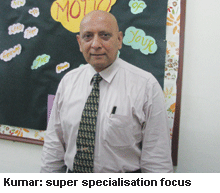 Curiously, ALS (enrolment: 720) which admitted its first batch of law students in 1999, well before Amity University was chartered, is one of two law schools within the Amity Group, and affiliated with the Delhi-based Guru Gobind Singh Indraprastha University. The Noida campus also houses the Amity University Law School (AULS, estb. 2004), which the five-year BA.LLB programme offered by ALS apart, offers its own designed B.Com-LLB and BBA-LLB five-year study programmes to 800 students. “While we accept ALS as our senior partner in legal education, the distinguishing characteristic of this law school is our focus on super special-isation and legal research into new frontier areas such as deep sea, space, transnational organised crime, trafficking in personnel and the illegal trade in small arms and light weapons,” says Major General (Retd.) Nilendra Kumar, a former Judge Advocate General of India recently appointed director of AULS.
Curiously, ALS (enrolment: 720) which admitted its first batch of law students in 1999, well before Amity University was chartered, is one of two law schools within the Amity Group, and affiliated with the Delhi-based Guru Gobind Singh Indraprastha University. The Noida campus also houses the Amity University Law School (AULS, estb. 2004), which the five-year BA.LLB programme offered by ALS apart, offers its own designed B.Com-LLB and BBA-LLB five-year study programmes to 800 students. “While we accept ALS as our senior partner in legal education, the distinguishing characteristic of this law school is our focus on super special-isation and legal research into new frontier areas such as deep sea, space, transnational organised crime, trafficking in personnel and the illegal trade in small arms and light weapons,” says Major General (Retd.) Nilendra Kumar, a former Judge Advocate General of India recently appointed director of AULS.
Indeed former top brass of the defence services and of the highly respected Indian Army in particular, constitute another layer — after the promoter Chauhan family and autonomous star faculty — of the Amity Group’s management structure. A plethora of generals and officers of the highly disciplined Indian Army provide the administrative systems and muscle, which marks out the spic and span Amity campuses as sharp contrasts with the environments of government and other private colleges and universities across the country.
For instance the vice chancellor (chief executive) of Amity University, Uttar Pradesh is Major General (Retd.) K. Jai Singh, former additional director general (systems) of the Indian Army; the director general of the Lucknow campus spread over 40 acres in Gomti Nagar, is Major General K.K. Ohri, PVSM (Retd); the director general of the Amity Insitutute of Space & Science Technology is Prof. V.P. Sandlas, former chief controller (research) of the Defence Research and Development Organisation (DRDO); and the Amity Institute of Advanced Research and Studies is headed by Dr. V.K. Jain, former director grade scientist of DRDO.
With their defence backgrounds these army top brass run a tight ship. Full 100 percent attendance of lectures is mandatory for all students who are also obliged to undergo a week’s compul-sory military training. Not surprisingly, the Amity campus in Noida — which also provides western-style single room per student en suite residential accommodation — is meticulously clean and well-maintained, and free from plastic waste and detritus which are common characteristics of higher education institutes in India.
By all indicators, the simultaneously loose-tight management style which the Chauhan pere et fils have evolved for the Amity Group is working well and explains Amity’s exponential growth within a moribund education sector almost ruined by the ubiquitous dead hand of government at the Centre and in the states. And perhaps the litmus test of the efficacy of Amity’s management style is that despite the market driven tuition fees they have to pay, students are satisfied that they’re getting value for money.
 Comments Shwetank Singh (22), a fourth year electronics and telecom engineering student from Jaunpur, Uttar Pradesh: “We have a modern syllabus and good curriculum which provides excellent industry exposure and IIT-standard education. I believe the tuition fee of Rs.100,000 per year — which is higher than most engineering colleges — is money well spent.” Adds Shivalika Gill, a second year business management (finance) student: “The residential accommoda-tion is excellent, the learning infrastru-cture is very supportive and we enjoy a good social life in a liberal campus environment.” Nor are these endorse-ments exceptional; they represent an overwhelming majority of student opinions.
Comments Shwetank Singh (22), a fourth year electronics and telecom engineering student from Jaunpur, Uttar Pradesh: “We have a modern syllabus and good curriculum which provides excellent industry exposure and IIT-standard education. I believe the tuition fee of Rs.100,000 per year — which is higher than most engineering colleges — is money well spent.” Adds Shivalika Gill, a second year business management (finance) student: “The residential accommoda-tion is excellent, the learning infrastru-cture is very supportive and we enjoy a good social life in a liberal campus environment.” Nor are these endorse-ments exceptional; they represent an overwhelming majority of student opinions.
Having devised and developed the growth strategy of outflanking educrats of the Union HRD ministry and UGC, and staffing the 150 institutions of Amity with highly qualified research-oriented academics delivering cutting edge education to eager-to-learn students, it’s hardly surprising that Dr. Chauhan, the visionary founder-chairman who took the risk of reverse migrating to India two decades ago to enter the red tape-intensive Indian education sector, believes that the best of Amity is yet to come. “I believe that we have developed a good higher education model which combines the scientific systems and pedagogies of the West with Indian culture and philos-ophy. Now our priority is to scale up our operations by establishing Amity K-12 schools and Amity universities in every state of India, and in every continent around the world. I don’t believe funding for this plan will be a constraint because we have a good business model and banks around the world are looking for sound, viable projects. Currently IIT and IIM professors are agitating for better salaries and may even go on strike. This will never happen in Amity because we value our faculty and will always ensure that our remuneration structure is market sensitive. Together our teachers, students and administrators have learned to create conducive environments in which real learning can take place,” says Chauhan.
Private sector initiatives in education — particularly if they are based on sound business principles — may be anathema to Left intellectuals and dog-in-the-manger educrats, but as the lengthening waiting lists of its 150 institutes and faculties testify, the Amity style of education provision is finding increasing takers within the nation’s fast-expanding middle class.